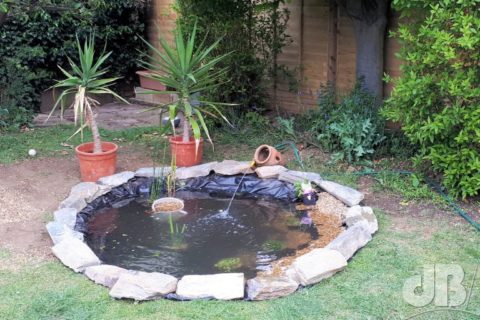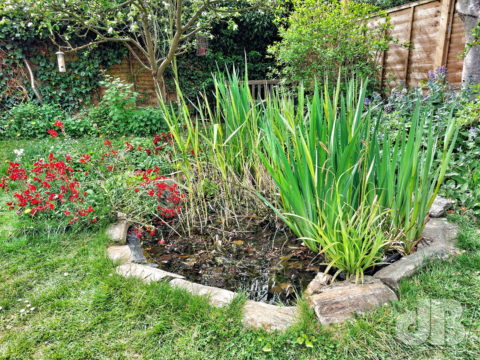UPDATE: 22nd Feb 2024 – Spawn present in the morning, perhaps been there a day or two, it’s been raining heavily so hadn’t checked since the weekend. 40+ frogs in the pond, mating activity still ongoing at the beginning of March, masses of spawn.
I have resculpted the rear edge of the pond to allow it to spill when it is very full and creates a potentially semi-permanent swamp area to increase invertebrate diversity. This was prompted by a chat with a member of our village nature recovery project.
2023: Several frogs active in our garden pond, some of them mating, but no spawn as of 2nd March 2023. UPDATE: 11th March, sudden appearance of spawn and ongoing frog activity, croaking, mating, at least 30 frogs. UPDATE: 11th April. Frog activity down, lots of tadpoles, one batch still very small an older batch looking big-headed and perhaps just about to start sprouting limbs.
I’ve not mentioned our wild garden pond for a while. It’s still thriving with iris, reed, and sedge shoots beginning to show already and it is just late February. Matt often checks on the frogs after dark and reported that there were a pair mating on the night of 26th February, which is a good sign, we might soon be with spawn again. We had spawn on 21st February 2021, but not until 5th March in 2020, nothing in 2019 when I’d only just resurrected the pond.


Just for the record, no fish. This is a wild pond for frogs, water snails, and dragonflies etc. Anything else that turns up by chance will find a home, but I’ve not introduced any creatures other than two species of watersnail from a friend’s wildlife pond.
I asked ChatGPT to act as a herpetologist to explain the lifecycle of the Common Frog:
The Common Frog, Rana temporaria, is a species of amphibian found throughout much of Europe and parts of Asia. Here’s a general overview of its lifecycle:
- Egg Stage: The lifecycle of a Common Frog starts when the female lays eggs in water, typically in ponds, lakes or slow-moving streams, usually in the spring. A female can lay up to 4,000 eggs in a single season. The eggs are enclosed in a gelatinous mass that floats on the surface of the water.
- Tadpole Stage: After several days, the eggs hatch into tadpoles. Tadpoles are aquatic and breathe through gills. They feed on algae and other small organisms found in the water. During this stage, they develop legs, absorb their tail and undergo metamorphosis.
- Metamorphosis Stage: As tadpoles grow, they start to develop legs and eventually lose their tails. They also start to breathe air through their lungs instead of gills, and their digestive system changes to accommodate a more carnivorous diet. This metamorphosis can take several months, depending on the temperature and food availability.
- Juvenile Stage: Once the metamorphosis is complete, the young froglets leave the water and begin their life on land. During this stage, they continue to grow and develop, and their diet shifts to insects and other small invertebrates.
- Adult Stage: After a few months, the young froglets reach sexual maturity and become adults. They will continue to breed and lay eggs, thus completing the lifecycle.
The entire lifecycle of a Common Frog typically takes around 2-3 years, although it can vary depending on environmental factors such as temperature and food availability.